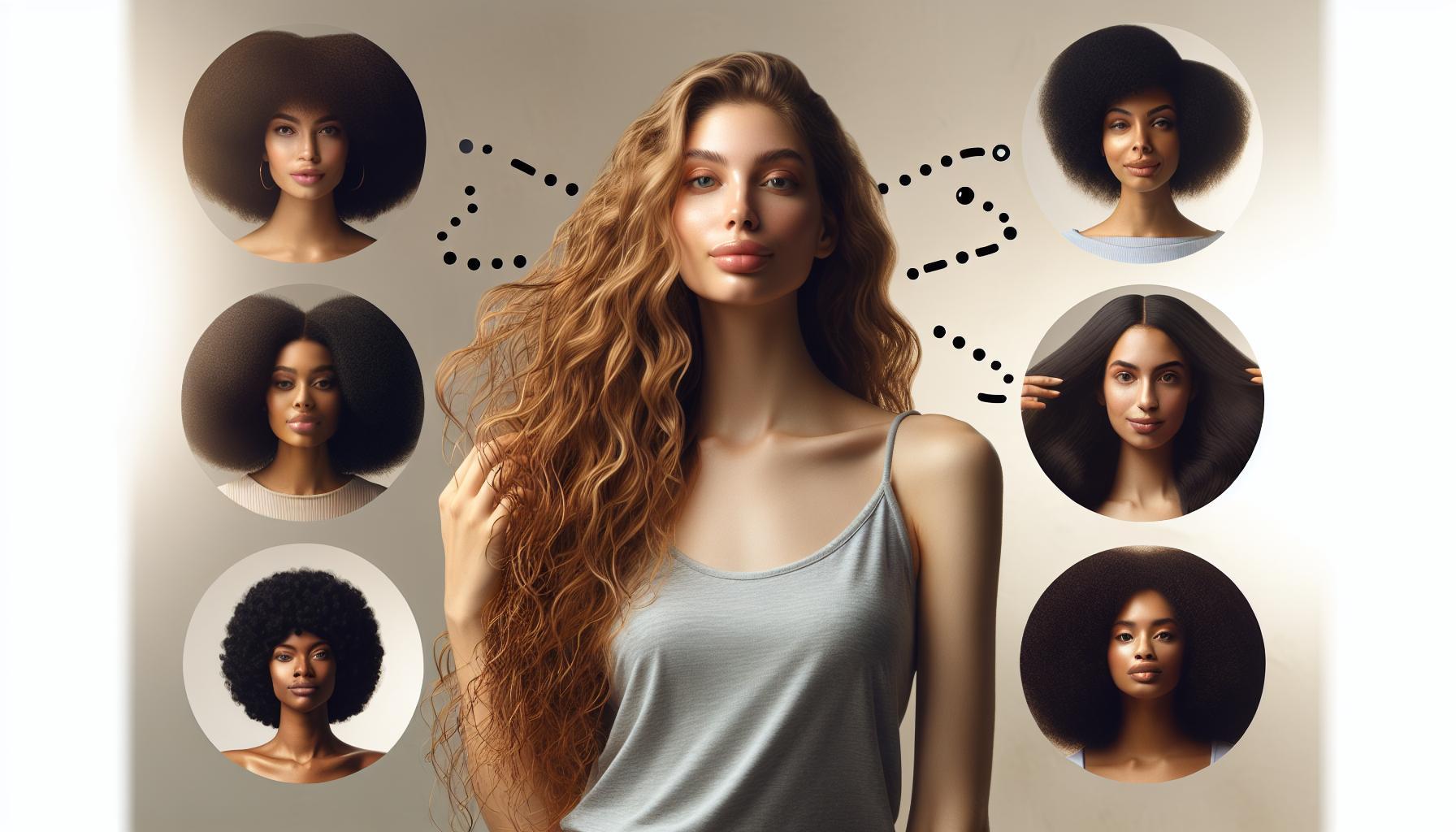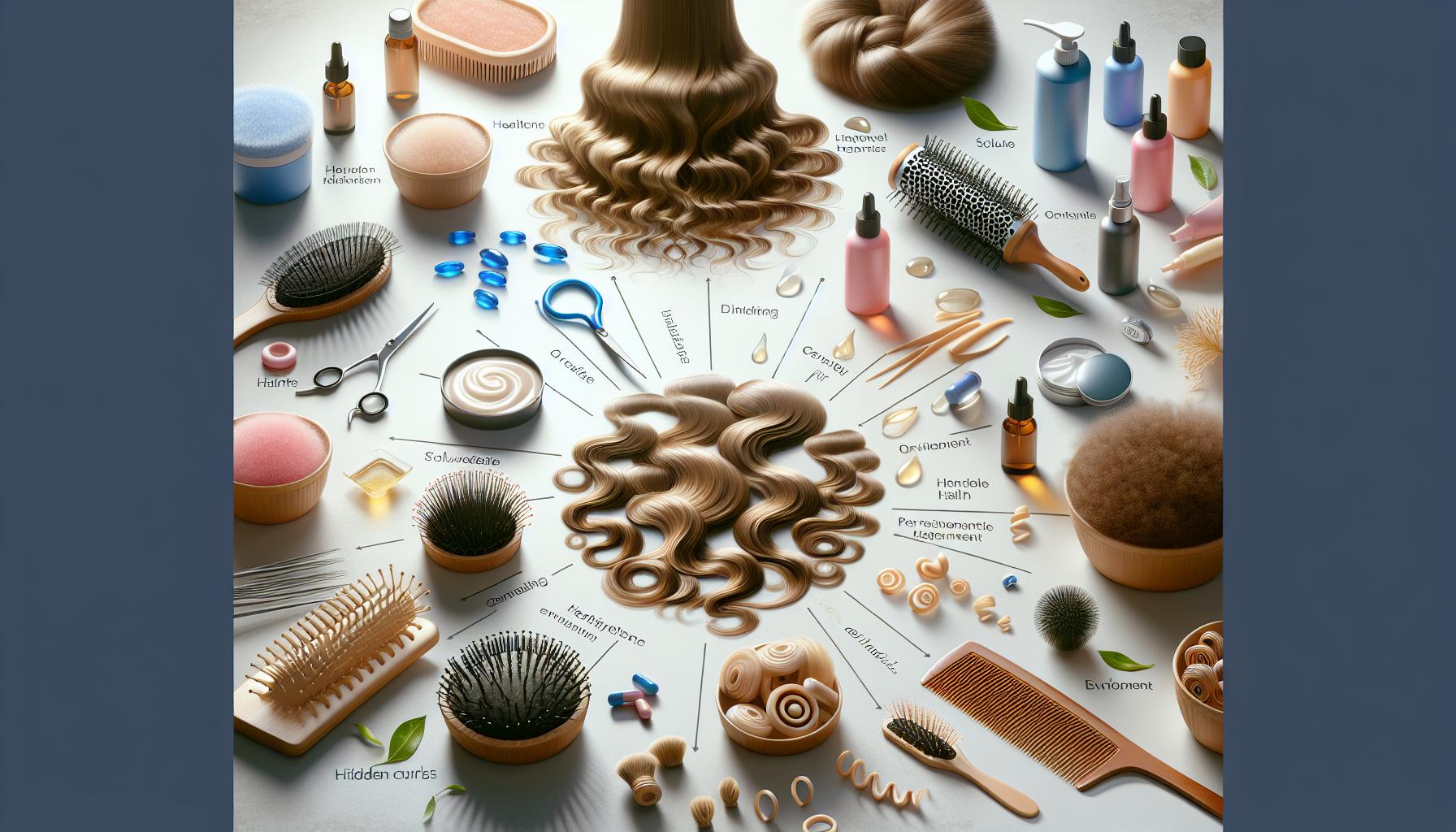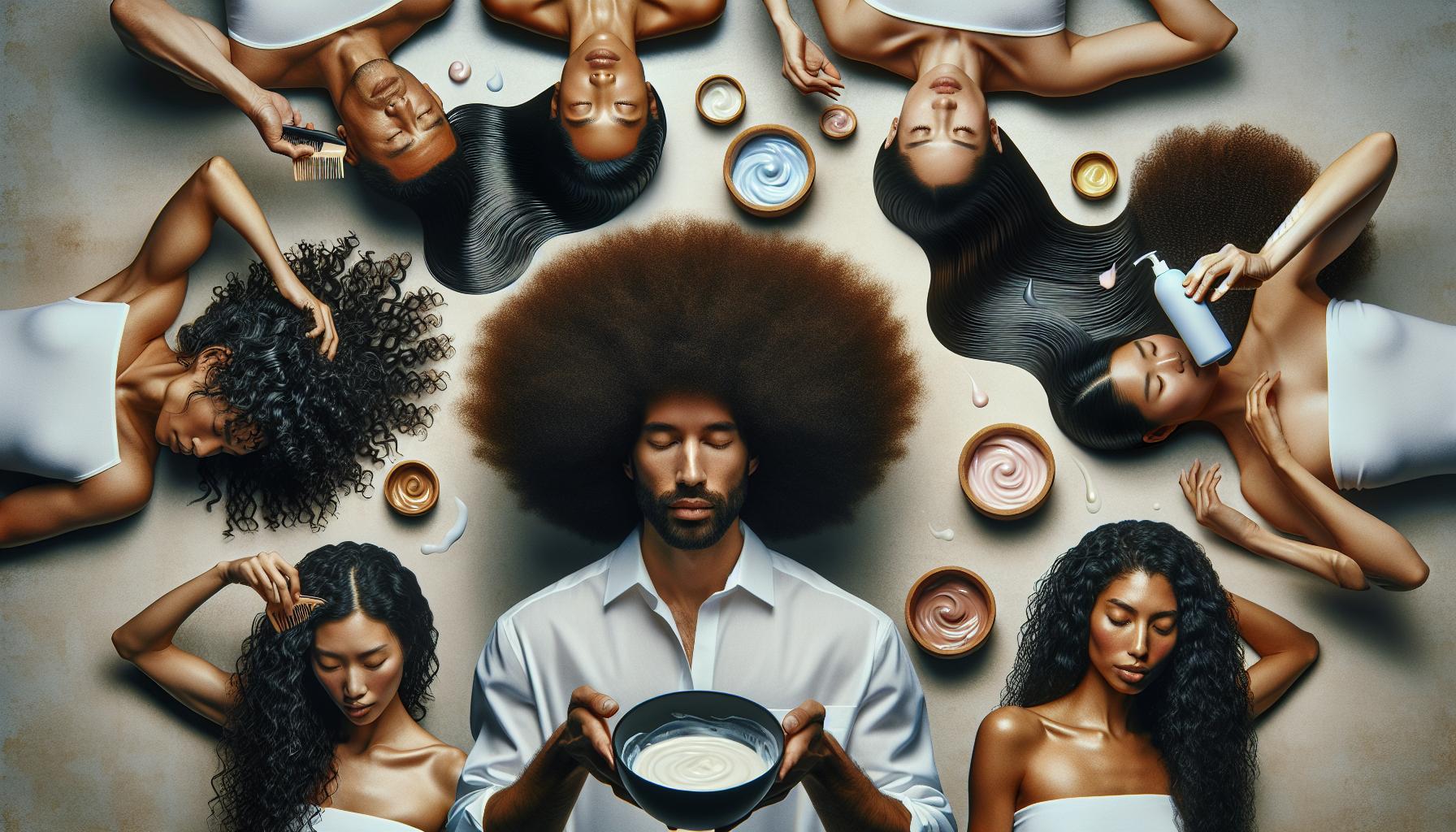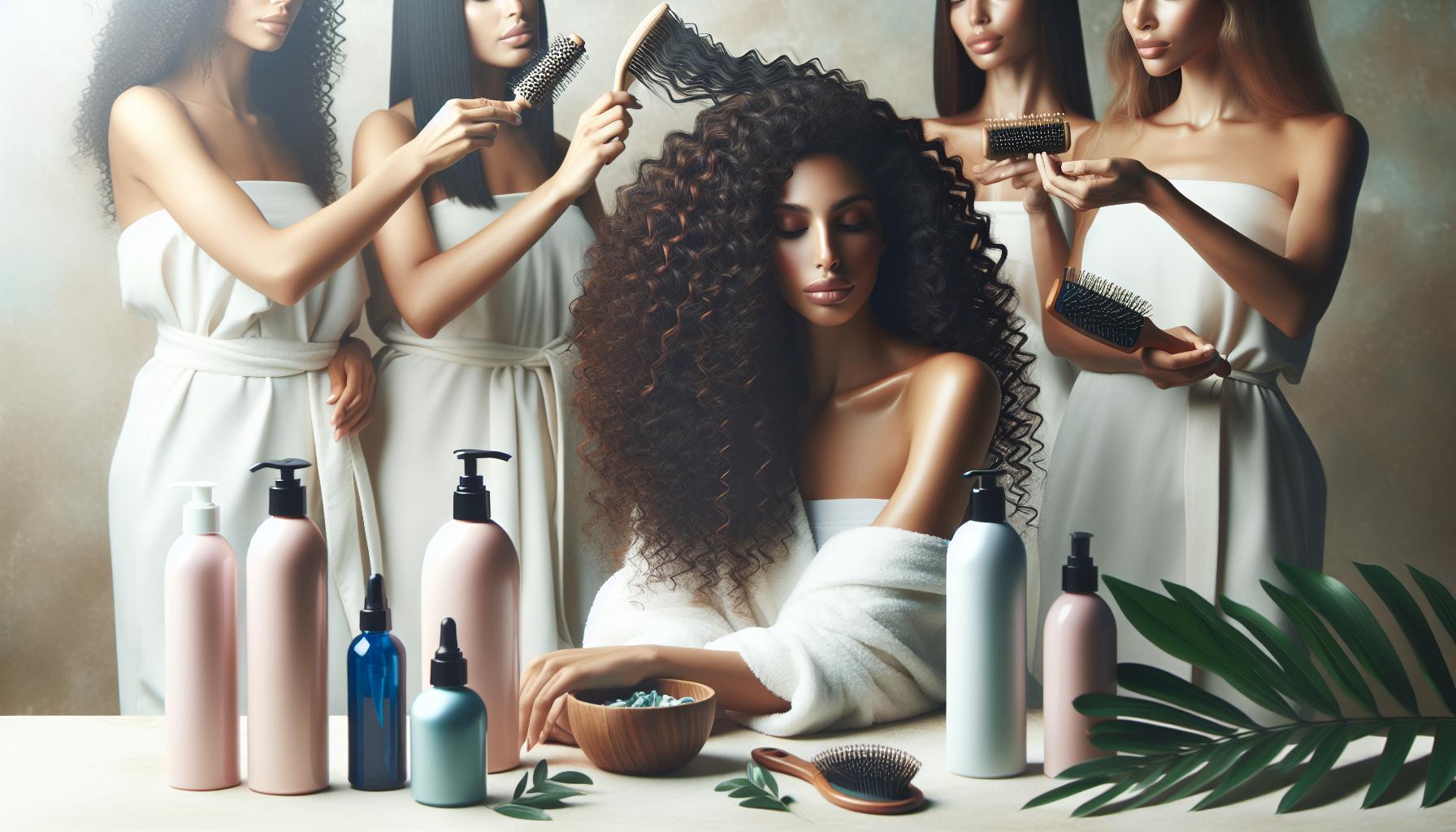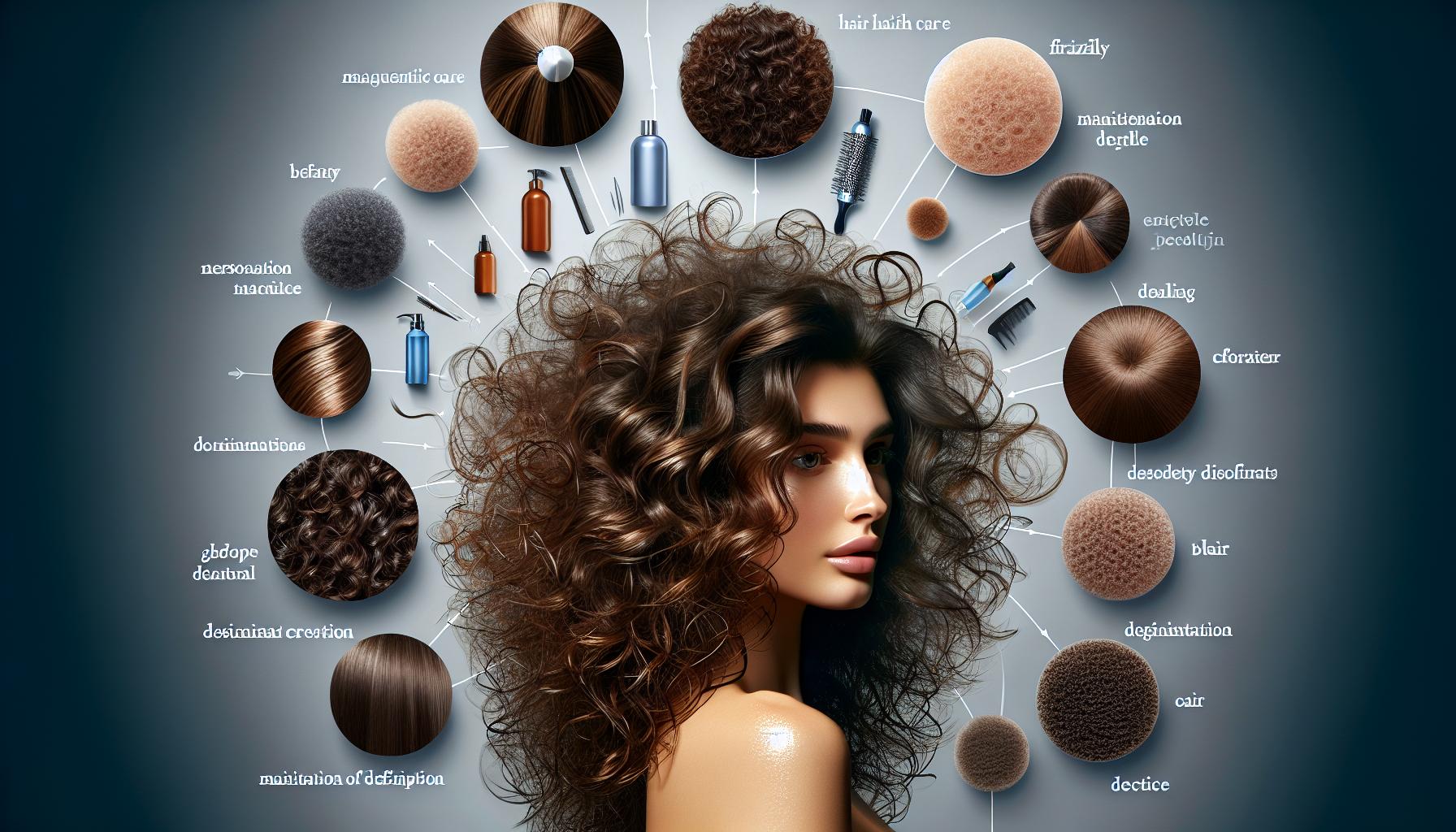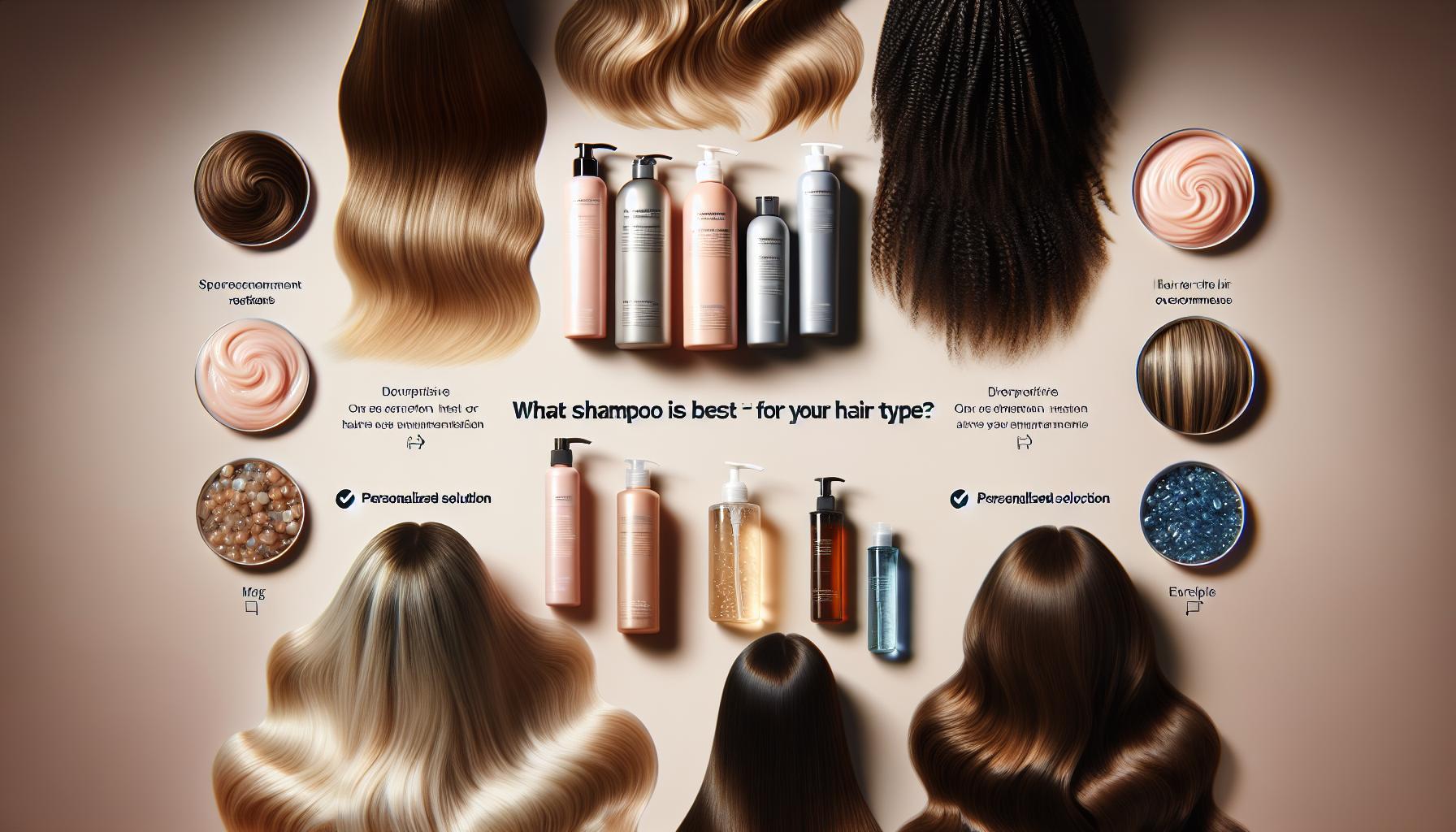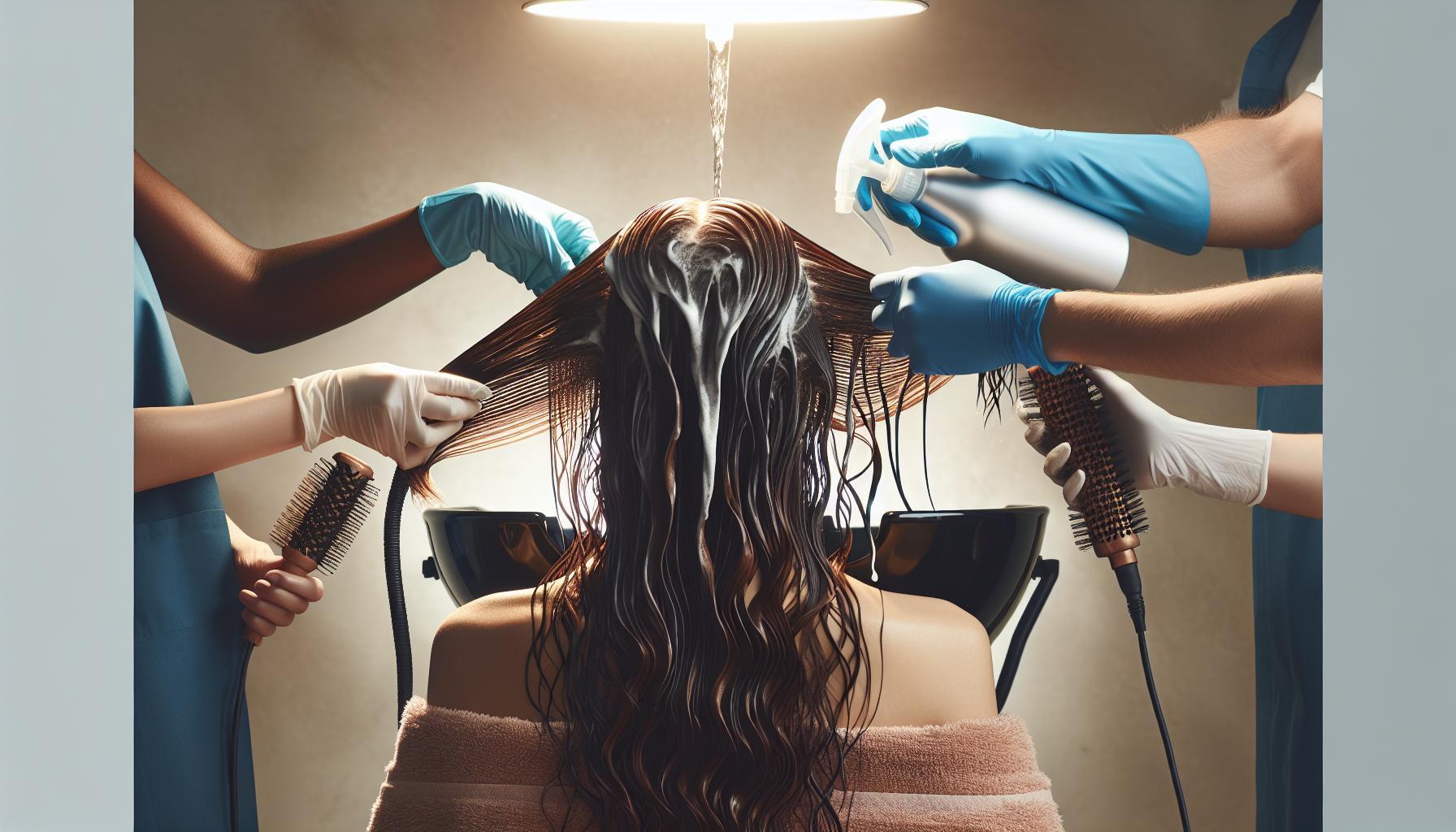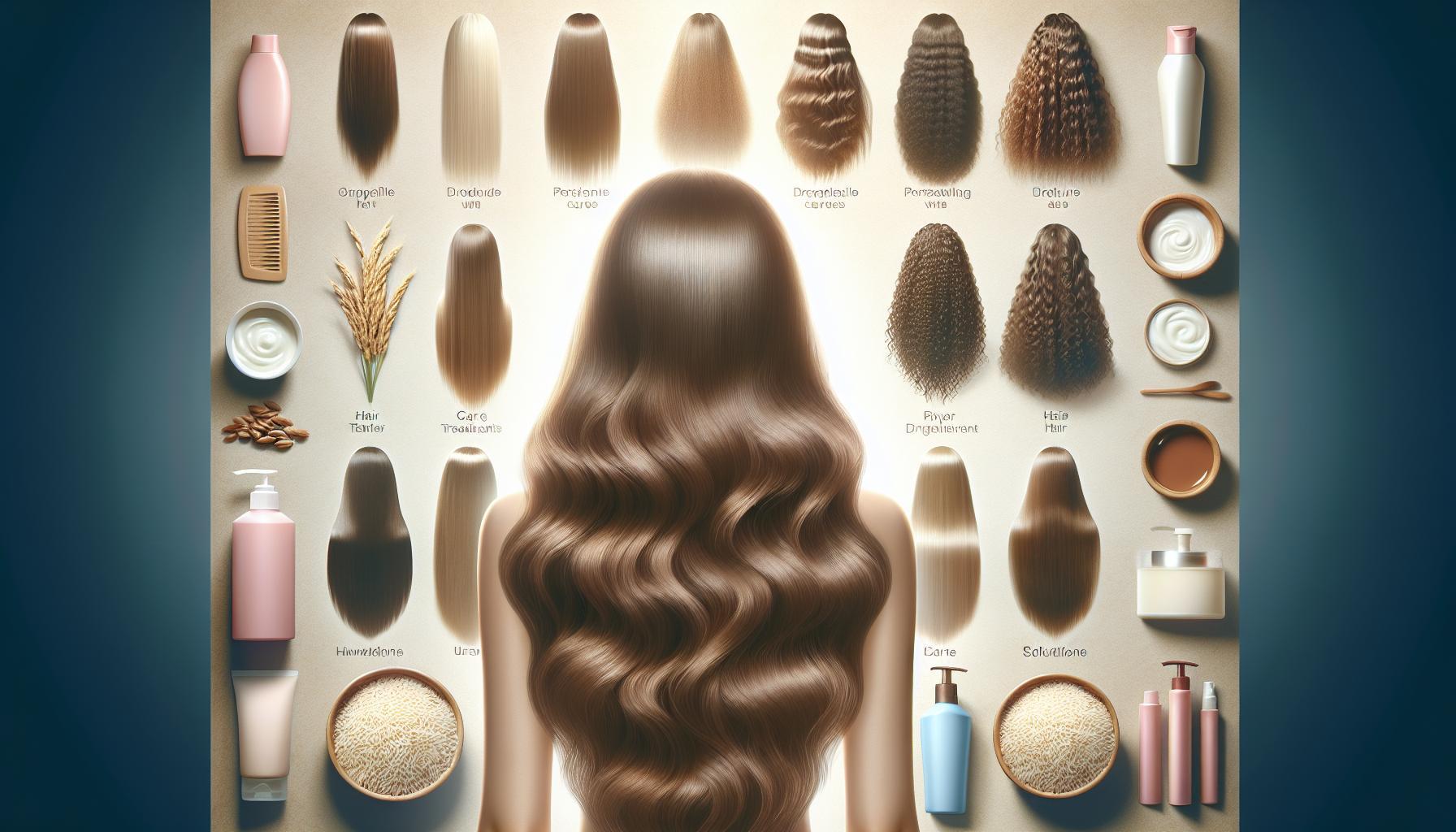Curly hair often surprises many, especially when the underneath layers reveal a different texture than what appears on the surface.Understanding why some strands curl while others remain straight is essential for effective styling and maintenance. The unique structure of hair follicles and the role of disulfide bonds significantly influence this phenomenon, guiding us to tailor our hair care routines for the best results.
Contents
- Understanding the Science Behind Curly Hair Patterns
- Common Causes of Hidden Curls: Genetics, Health, and Environment
- How Your Hair Care Routine Influences Curl Patterns
- Styling Techniques to Embrace and Enhance Your Natural Curls
- Product Choices: What to Use for Curly Hair Beneath
- Managing Frizz and Maintaining Definition in Curly Hair
- the Role of Humidity and Hair Texture: What You Should Know
- Frequently asked questions
- Future Outlook
Understanding the Science Behind Curly Hair Patterns
Curly hair is frequently enough seen as a source of beauty and expression,yet many individuals find themselves wondering about the underlying reasons for varying curl patterns. Understanding the science behind why hair may be curly underneath speaks not only to genetics but also the intricate structure of hair itself. The unique shape of hair follicles impacts curliness; oval or asymmetrical follicles typically produce curlier hair, while round follicles yield straighter strands. This natural variance explains why some people notice a stark contrast between the top layer of their hair and the curls that lie beneath.
to delve deeper, it’s essential to consider the physical properties of hair. Hair is composed of a protein called keratin, and its bonds, especially disulfide bonds, play a significant role in determining curl structure. When curls are formed, these bonds create a bended or curled shape, resulting in the ascendant waves that are characteristic of curly hair types. Environmental factors,such as humidity,can also influence how these curls behave,frequently enough causing them to react differently based on moisture levels in the air [[2]].Another important aspect is hair porosity, which refers to how well hair can absorb and retain moisture. Understanding porosity can significantly shape decisions around hair care products and routines. Low porosity hair often repels moisture, making it challenging for curls to lock in hydration, whereas high porosity hair absorbs moisture easily but may struggle to retain it [[1]].Identifying your hair’s porosity can lead to tailored solutions that enhance curl definition and health.
Here’s a fast comparison of hair porosity types and their characteristics:
| Porosity Type | Characteristics | Care Tips |
|---|---|---|
| Low Porosity | Resists moisture absorption, often appears shiny | Use heat to open cuticles, opt for lighter products |
| Medium Porosity | Balances moisture retention and absorption | Regular use of balanced products works well |
| High Porosity | Absorbs moisture quickly, often prone to damage | Opt for heavier creams and sealants to lock in moisture |
By understanding these underlying principles and recognizing how factors like curl patterns, hair structure, and porosity interact, individuals can take actionable steps toward addressing the question: “Why is my hair curly underneath?” From selecting the right styling products to adopting specific care routines, the journey to achieving beautiful, well-defined curls starts with knowledge and personalized care tailored to one’s unique hair characteristics.
Common Causes of Hidden Curls: Genetics, Health, and Environment
Understanding the mystery of why some individuals have curls that seem to hide away can be enlightening. Often, the answer lies within a combination of genetics, health factors, and environmental influences. These elements play crucial roles in determining how our hair behaves, leading to the finding of curls that may not be instantly visible.
Genetics
Genetic factors are one of the primary reasons behind the phenomenon of hidden curls. The inheritance of hair texture is a complex trait influenced by multiple genes, and even if one comes from a family of straight-haired individuals, it’s possible to inherit hidden curly genes.The curl pattern may be subdued due to dominant straight hair genes, causing the curls to remain less pronounced. As hair is often passed down from parent to child, individuals might discover their hidden curls in adulthood, especially when they allow their hair to air dry or when cut in a style that enhances its natural texture.
Health Factors
Health plays a significant role in hair texture and behavior.Hormonal changes, for instance, can dramatically alter how curls form. Conditions such as polycystic ovary syndrome (PCOS) and thyroid imbalances can cause hair to change significantly in texture over time. Additionally, nutritional deficiencies, such as a lack of protein or essential fatty acids, can lead to dryness and breakage, suppressing the natural curl.Maintaining a balanced diet rich in vitamins can help nourish hidden curls back to life.
Environmental Influences
The environment also impacts the visibility of curls. Environmental stressors such as humidity, pollution, and heat can affect how hair curls.Heat styling tools, frequent coloring, and the use of harsh hair products can lead to damage and buildup, hiding the natural curl pattern beneath frizz and dryness. To combat this, consider implementing a regimen that includes:
- Regular deep conditioning treatments to hydrate curls.
- Monthly clarifying washes to remove buildup.
- Protective styling techniques to minimize heat exposure.
By understanding these factors—genetics,health,and environmental influences—individuals can begin to uncover the hidden curls in their hair. Exploring these influences can lead to effective styling solutions and improve overall hair health, revealing the luscious curls that lie beneath the surface.
How Your Hair Care Routine Influences Curl Patterns
Understanding how your hair care routine impacts curl patterns can significantly enhance your styling results and overall hair health. every product application and treatment choice plays a crucial role in defining, maintaining, or even altering your natural curl pattern. For those wondering,”Why is my hair curly underneath?” the answers lie not just in genetics but also in the daily methods and products used to care for your hair.
A consistent hair care regimen tailored to your specific curl type is essential. The complexity of curl patterns—ranging from wavy (type 2) to coily (type 4)—requires different approaches. For anyone dealing with distinct curl patterns, especially the phenomenon of having curly hair underneath straighter strands, implementing the right products can help in managing frizz and enhancing curl definition. This customization can mean the difference as you choose products rich in moisture for tighter curls or lightweight formulations for looser ones.
Key Practices for Enhancing Curl Patterns
To effectively influence your curl patterns for the better, consider the following hair care practices:
- Hydration is Key: Use deep conditioning treatments regularly to maintain moisture levels, which helps prevent frizz and supports curl definition.
- Component Awareness: Choose products that avoid sulfates and silicones, which can strip natural oils and cause buildup, hindering curl formation.
- Proper Drying Techniques: Opt for air-drying or using a diffuser on a low setting, as vigorous towel-drying can disrupt curl patterns.
- Curl-Enhancing Products: Leverage curl creams or gels that define curls without weighing them down. Experiment with different formulations to find what best suits your hair type.
Table of Recommended Products by Curl Type
| Curl type | Recommended Product Type |
|---|---|
| Wavy (type 2) | Lightweight styling mousse |
| Curly (Type 3) | Moisturizing curl cream |
| Coily (Type 4) | Rich curling custard or gel |
By implementing a hair care routine that is not only consistent but also attuned to your hair’s unique needs,you can genuinely influence the patterns of your curls. This tailored approach can offer insights and solutions for anyone grappling with the underlying curliness of their hair, taking significant steps towards thriving curls that reflect your unique style.
Styling Techniques to Embrace and Enhance Your Natural Curls
Understanding how to style and embrace your natural curls can transform your hair routine from a frustrating chore into an empowering expression of your individuality. Many individuals discover that their hair has a beautiful texture underneath other layers, often leading to the question: why is my hair curly underneath? The reasons may vary from genetic factors to how hair is styled and treated. the good news is, regardless of the underlying texture, there are numerous techniques to enhance and celebrate those curls.
Embracing Your Natural Texture
To effectively embrace your natural curls, it’s vital to start with a solid foundation:
- hydration is Key: Ensure your hair is well-hydrated. Consider using a moisturizing shampoo and conditioner specifically designed for curly hair to combat dryness, which can lead to frizz and prevent curls from forming properly.
- Product Selection: Choose products that suit your curl type.Look for curl creams or gels that provide hold without stiffness. For instance, products with natural ingredients like shea butter and coconut oil can nourish your curls while enhancing their structure.
- Application Techniques: Experiment with different methods like the “pray and scrunch” technique or finger-coiling to define your curls more clearly.
Innovative Drying Techniques
How you dry your hair after washing plays a significant role in the final curl formation. Standard towels can cause friction and frizz; rather, consider:
- Cotton T-Shirts: use a soft cotton T-shirt to gently squeeze out excess water from your curls. This method reduces frizz and enhances curl definition.
- Plopping: This technique involves placing your wet hair in a T-shirt or microfiber towel to dry in a way that promotes natural curl formation.
- Diffuse Drying: If you’re using a blow dryer,attach a diffuser to distribute the heat evenly without disrupting your curl pattern. Using a low heat setting can minimize damage while enhancing the overall look of your curls.
Styling and Finishing Touches
Once your hair is dry, finishing touches can make all the difference. Consider:
- Scrunch Out the Crunch: If you used a gel that makes your curls feel stiff, gently scrunch your hair with your hands to break the cast and reveal softer curls.
- Pin Curls: For added volume and long-lasting definition, try pinning curls up with clips or pins after applying product while your hair is still damp.
- Regular Trims: keep your ends healthy with regular trims. This not only prevents split ends but also helps maintain the shape of your curls.
By employing these styling techniques and incorporating them into your routine, you can effectively navigate the complexities of your unique curl pattern, as explored in relation to the question, “why is my hair curly underneath?” Celebrate your natural texture and let your curls shine with confidence!
Product Choices: What to Use for Curly Hair Beneath
Many people with curly hair frequently enough notice a distinct difference between the curls on the surface and those underneath. This phenomenon can be attributed to various factors, including how hair is layered, environmental effects, and even hair care practices. understanding what products work best for different types of curls—especially those hidden beneath—can significantly enhance overall hair health and appearance.
When selecting products for curly hair that may be curly underneath, it’s essential to prioritize hydration and definition. Curly hair generally craves moisture,so choosing products that fulfill this need is crucial. here are some excellent options:
Recommended Products for Curly Hair
- Verb Curl Collection: this collection is designed to hydrate, define, and eliminate frizz, keeping curls soft, bouncy, and healthy. Ideal for all curl types, these products can help manage the often-neglected curls beneath your outer layers.[1]
- Curlsmith Post-Biotic Calming Conditioner: Perfect for those who experience itchy scalps, this conditioner soothes and hydrates while enhancing curl definition. It’s particularly effective for curls that may feel dry or unruly underneath.[2]
- Aussie miracle Curls Frizz Taming Curl Cream: This cream actively fights frizz while defining curls, making it a smart choice for taming stubborn curls lying beneath. Its lightweight formula ensures that your hair does not feel weighed down.[3]
By employing these specially formulated products, users can better care for their curls, especially those hidden away and often neglected. Adapting your hair care routine to include these options may yield significant improvements in managing the distinctive behaviors of your hair. Regular application can enhance your curls’ definition, reduce frizz, and ensure that your curls, whether on the surface or beneath, remain vibrant and healthy.
Managing Frizz and Maintaining Definition in Curly Hair
Curly hair can be a beautiful yet challenging texture to manage, especially when it comes to frizz and curl definition.Many curly-haired individuals often find themselves grappling with the question,”Why is my hair frizzy and undefined?” The battle against frizz is multifaceted,influenced by factors such as humidity,hair care products,and styling techniques. Understanding how to effectively manage frizz while maintaining your curl pattern can transform your hair care routine and enhance your overall style.
Essential Products for Frizz Control
To achieve sleek curls and minimize frizz, the right products are essential. While many assume that conditioner is the ultimate solution, it often isn’t sufficient on its own. Rather,consider incorporating the following into your routine:
- Sulfate-Free Cleansers: These gentle cleansers help maintain your hair’s natural oils,preventing dryness that can lead to frizz.
- Moisturizers: A good leave-in conditioner or moisturizer can significantly reduce frizz by hydrating the hair.
- Styling Creams and Gels: Products designed to provide hold and shape can definitely help keep curls defined and frizz at bay as they dry, reducing the chances of frizz formation after styling [[1]](https://www.reddit.com/r/curlyhair/comments/m6w0ai/psa_the_cure_to_frizz_is_not_conditioner/).
Maintaining moisture is key, particularly in humid climates where frizz can thrive. Look for products that include natural oils or butters, as these ingredients will not only nourish your curls but also provide a protective barrier against environmental factors.
Protective Styling Techniques
Incorporating specific styling techniques can also help in keeping frizz under control. Here are some tips to maintain curl definition throughout the day:
- Avoid Heat Styling: Whenever possible, choose air-drying over blow-drying to reduce damage and frizz.If heat is unavoidable, use a heat protectant.
- Finger Coiling: This technique involves wrapping small sections of hair around your finger to encourage curl formation, which helps reduce frizz.
- Pineapple Method: This nighttime method involves loosely gathering curls at the top of your head to prevent tangling and flattening while you sleep.
By integrating these practices into your hair care regimen, you can enjoy well-defined curls with minimal frizz. Emphasizing a focus on hydration,suitable styling products,and gentle handling of your curls will enhance your hair health and appearance.
Conclusion
Learning to manage frizz and maintain curl definition can dramatically improve your hair’s look and feel. By understanding the causes of frizz and integrating effective techniques and products into your routine, you’ll be better equipped to face the unique challenges that come with curly hair. the journey to beautiful, manageable curls is well worth the effort!
the Role of Humidity and Hair Texture: What You Should Know
Humidity plays a pivotal role in the way different hair textures respond to environmental conditions, often causing unexpected changes that leave many wondering, “why is my hair curly underneath?” Understanding how humidity affects your hair can help you implement effective solutions for styling and care. When the air is saturated with moisture, the hydrogen bonds within hair strands shift, leading to frizz and changes in texture. This is particularly notable for those with curls hidden beneath straighter hair—humidity can bring these curls to the forefront, creating a beautiful yet surprising look.
How Humidity Affects Different Hair Types
Different hair types react distinctly to high humidity. Straight hair sometimes waves or becomes flat, depending on the individual’s hair structure and moisture levels. In contrast, curly hair can become more defined when exposed to moisture, but it can also frizz if not properly cared for. To manage these changes, consider the following tips:
- Anti-frizz products: use serums or creams specifically labeled as anti-frizz to help maintain smoothness.
- Style versatility: Embrace styles that work with your natural texture, such as braids or buns, which can keep hair looking polished even in humid conditions.
- Moisture management: Regularly deep-condition your hair to keep it hydrated and less likely to absorb excess humidity.
Understanding how humidity interacts with your unique hair texture is crucial in developing effective styling solutions. For instance,many find that wearing their hair up in a bun or ponytail not only keeps hair manageable but also allows curls to breathe when they do emerge.
preventing Frizz and Enhancing Definition
Adapting your hair care routine can significantly impact how your hair behaves in humid conditions. here’s a simple table to illustrate practical products and techniques you can incorporate:
| Product/Technique | Purpose |
|---|---|
| Anti-humidity hairspray | Creates a barrier against moisture |
| Curl defining cream | Enhances and maintains curl shape |
| Silicone-based serums | Locks in moisture and prevents frizz |
| Loose hairstyles | Reduces tension on hair and allows natural texture |
understanding the role of humidity in relation to your hair texture can empower you to embrace your natural beauty while effectively managing any challenges. Whether you’re pondering “Why is my hair curly underneath?” or trying to find the best styling methods, knowing how to adapt to humidity is key to achieving the look you desire.
Frequently asked questions
Why is my hair curly underneath?
Curly hair underneath can result from genetic factors or how hair is styled and cared for. The natural curl pattern may not be visible due to weight from longer top layers. Understanding how your hair’s porosity affects styling is crucial. Curly hair tends to be drier and more porous, which influences how moisture is absorbed and retained [[1](https://www.kerastase.com/kerastase-club/most-asked/hair-guide/the-scientific-truth-behind-curly-hair)]. The differing texture can lead to curls being more pronounced underneath, especially when the top layers are straightened or styled differently.
What causes uneven curl patterns in hair?
Uneven curl patterns can be due to genetics or the effects of heat styling and chemical treatments. Each hair strand can react differently to environmental factors, leading to some curls being tighter or looser. Additionally,hair texture can change due to health,aging,or hormonal fluctuations,impacting how curls form [[1](https://www.kerastase.com/kerastase-club/most-asked/hair-guide/the-scientific-truth-behind-curly-hair)]. To maintain consistent curls, consider adopting the Curly Girl Method, which focuses on gentle products and techniques.
Can I relax my curly hair underneath?
Yes, you can relax curly hair underneath, but it’s essential to approach this with caution. Chemical relaxers can damage hair bonds and lead to breakage if not applied correctly. If relaxing, consider consulting with a professional stylist who understands your hair’s unique texture and can recommend appropriate products. Regular deep conditioning treatments will help maintain moisture and strength during this process.
How can I enhance my curly hair underneath?
To enhance curly hair underneath, focus on proper hydration and styling techniques. Use products specifically designed for curly hair, like leave-in conditioners and curl creams. Applying these products while your hair is damp can definitely help improve curl definition. Also, consider techniques like the “pineapple method” for sleeping, which preserves curls and reduces frizz [[2](https://www.reddit.com/r/curlyhair/comments/8klm9t/new_curlies_start_here/)].
Why does my hair feel different underneath?
Hair can feel different underneath due to varied exposure to environmental factors and products. The top layers of hair are usually more exposed to heat and styling products,making them smoother compared to underneath layers,which might be curlier and drier. It’s essential to maintain a consistent hair care routine that hydrates all layers equally for balanced texture.
what styling products work best for curly hair underneath?
The best products for curly hair underneath are those that provide moisture and define curls. Look for curl-enhancing gels and creams that are free of sulfates and silicones to avoid buildup. It’s also beneficial to use a light leave-in conditioner to keep curls hydrated throughout the day[[[[[3](https://colorwowhair.com/blogs/all/curly-hair-the-ultimate-guide?srsltid=AfmBOoqVHSj18VV2XIDOAmoLoEKP69pOprKydzTRjkDeWd8jBb3CXpOJ)]. Experiment to find the right balance that works for your unique curls.
Can I change my curly hair texture?
While you can temporarily change your hair’s texture with styling, permanent changes require chemical treatments. Options like relaxing or perming can alter your natural curl pattern but can also damage your hair if done improperly. Embracing your natural texture is often the healthiest choice, but if you do decide to change it, seek help from a professional stylist to minimize damage.
Future Outlook
Understanding why your hair is curly underneath can unlock a world of styling possibilities and greater self-acceptance. Curly hair can stem from genetic factors, individual hair porosity, and even the way hair is cut and styled. By recognizing the underlying causes—such as differential shrinkage or varying hair textures—you’re better equipped to address them with tailored solutions.
To manage and embrace your beautiful curls, consider incorporating hydrating products, proper diffusing techniques, and protective methods while you sleep. Experiment with hold products like gels or mousses that can define your curls without weighing them down. These practical steps can help you leverage your unique hair texture to its fullest potential, allowing you to express yourself more freely.
We hope this article has provided you with valuable insights into your curly hair and armed you with actionable strategies for styling. Don’t hesitate to explore further resources and community discussions; connecting with others who share similar experiences can inspire new techniques and foster a deeper understanding of your hair.Celebrate your curls, and remember, you have the power to define your style!

